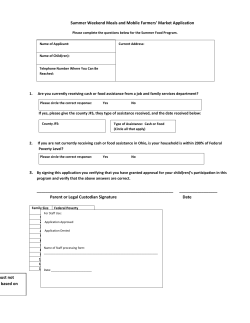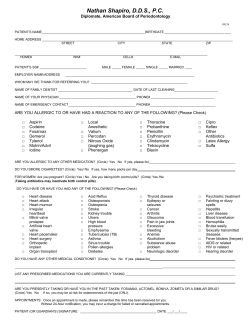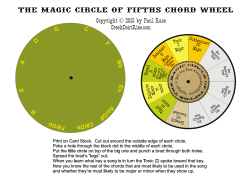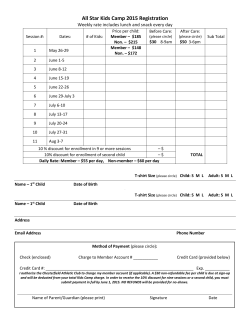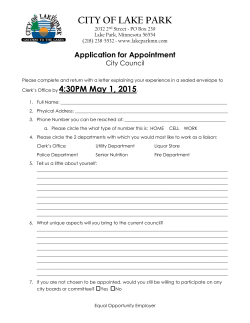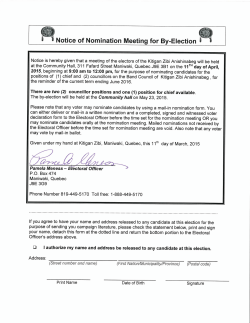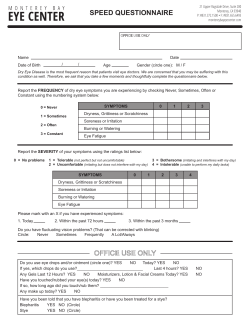
Evaluation and Community Engagement
L BU OF IL G THE FIE D D IN N E M M M EN T | | CO U IT Y ENG AG WWW.BUILDTHEFIELD.ORG Contact: Janice Barbee, janicegwb@yahoo.com or Theresa Gardella, tgardella@nexuscp.org Written by: Building the Field of Community Engagement partners and Tracy Babler You are free to share, copy and distribute this material. We ask that you give appropriate credit to Building the Field of Community Engagement and/or its partners. We encourage you to share your feedback with us and tell us how you are using the tools and documents on our comment page at www.buildthefield.org. The partners in the Building the Field of Community Engagement initiative intend these documents and tools to introduce practitioners, funders, evaluators and community members to community engagement, to give the field clarity in its language and principles. However, community engagement is not a field that can rely on written materials alone; it takes a community of experienced practitioners to support people new to the field in practicing community engagement effectively, meeting its challenges, and tapping the strengths within each unique context. We encourage you to seek out experienced practitioners to support you in implementing these tools, principles and concepts. The partners in Building the Field of Community Engagement are available for consultation. Please contact us at www.buildthefield.org or email Janice Barbee at janicegwb@yahoo.com. © Nexus Community Partners and the Building the Field of Community Engagement Partners BU OF IL G THE FIE L D D IN N E M M M EN T | | CO U IT Y ENG AG Building the Field of Community Engagement is a collaborative initiative designed to magnify and elevate the power of community engagement to change the way problems are solved and resources are invested. Building the Field is bolstering the work of community engagement practitioners and encouraging other organizations to integrate community engagement into their work. As part of the project, the partners produced a film, Community at the Center, which discusses the core principles and values of this important work. They also host the Engaged Learning Series, which are community conversations on critical community engagement topics. This report is part When the Building the Field of Community Engagement partners began exploring issues important to the field of community engagement, evaluation quickly surfaced as one of the most universal challenges. Even the most experienced practitioners asked: How do you capture the impact of community engagement? Finding ways to evaluate community engagement is critical if this work, and the communities it impacts, are to prosper. At the Building the Field of Community Engagement initiative’s fourth Engaged Learning Series event, Evaluation and Community Engagement, the partners brought together funders, evaluators and community engagement practitioners to discuss this critical issue in the field of community engagement. of a series of tools and stories that document the partners’ and other practitioners’ expertise and learning. Find us at www.buildthefield.org. Building the Field partners: Casa de Esperanza Cultural Wellness Center Hope Community Lyndale Neighborhood Association Native American Community Development Institute Nexus Community Partners Nonprofit staff, funders, and evaluators meet together at the Engaged Learning Series event on February 11, 2015. page 1 of 8 © 2015 Building the Field of Community Engagement It is important to ground the discussion about the evaluation of community engagement in a discussion about why organizations use an engagement approach. Community engagement authentically builds power in people to change their lives and their communities. Organizations committed to community engagement invite participation in planning and implementing work to improve the community. Engagement is both a process and an outcome in itself; it leads to better collective decisionmaking and a healthier community. Any evaluation of community engagement must be committed to an approach that advances these goals and values the knowledge and experience of people in the community. The Building the Field partners developed the Impacts of Community Engagement graphic to demonstrate the interplay between two types of outcomes. The inner circle shows the outcomes of an engaged community, such as strengthened identity and growing social networks. Those inner circle outcomes create more sustainable outer circle outcomes, such as increased employment and educational improvement. The outer circle outcomes are the more traditionally measured and understood outcomes. page 2 of 8 © 2015 Building the Field of Community Engagement Akhmiri Sekhr-Ra of the Cultural Wellness Center welcomes participants and presents the agenda for the morning. The Engaged Learning Series event surfaced several recommendations that will be instructive in future conversations about the evaluation of community engagement. There are two big questions in the evaluation of community engagement. First, are people engaged? People discussed the need to do more than document that people are showing up; the field of community engagement needs some clear indicators of what it means for people to be engaged (see page 4 for some examples). The second question for evaluating community engagement is: how do you show the impacts of people being engaged? The impact graphic offers two circles of impacts that can be evaluated. The inner circle shows engagement outcomes that are often unseen or too often undervalued, while the outer circle shows more easily seen and measured personal or community outcomes. Both are of value, and it was clear from the discussion that the field needs more creative evaluation methods that can show that engagement leads to both types of outcomes. Several people at the event talked about “living in the arrows” of the impact graphic. They challenged the field to find a way to evaluate the interplay between the circles of impact. The evaluation of community engagement needs to be based in the principles and values of community engagement. Consistent with these practices, community members should participate in and have a stake in the evaluation questions, design, methods, implementation, interpretation and use. Evaluators can be brought in as resources rather than as authority figures positioned with more power and expertise than the community. The key indicators of such evaluations will likely be different from what is measured in an evaluator-led project. A community evaluating itself is a powerful outcome of engagement. Outcomes-based evaluation, as typically implemented in the public and nonprofit fields, attempts to measure the changes and benefits to individuals or communities as a result of the organization’s work. But with community engagement, even more so than most public or nonprofit work, causality is difficult to determine and multiple outcomes are desired. Demonstrating how community engagement contributes to the outer circle outcomes (housing, health, employment, page 3 of 8 © 2015 Building the Field of Community Engagement Indicators of Community Engagement Evaluation helps us to learn, to do our work better, to be accountable to community and funders, and to support funder-allies in advocating on our behalf. The partners name below some of the ways they know the inner circle outcomes of community engagement are being achieved. We know community engagement is working when people/groups/communities: Voice their concerns and visions Bring other people with them to events Take on community work Share information with others Take steps to make a situation better Express confidence in their ability to make change Connect people with those who share common experiences Share their stories publicly and experience people listening deeply Move away from a place of hurt/anger/fear Ask for help when they want it Plan and attend community celebrations and gatherings Express pride in their culture Utilize cultural norms, art and symbols in their work Define shared beliefs and values that may challenge those of the dominant culture Work with others Show respect and trust in one another (e.g., young people and elders) Offer help and support to others Name common values and visions Display confidence in self and others Develop a sense of belonging page 4 of 8 © 2015 Building the Field of Community Engagement etc.) on the impact graphic is challenging because an organization’s engagement work cannot be isolated as the single factor in any change. It is impossible to separate the work of engagement (or any other work for that matter) from other factors, such as policies; economic, social, and environmental conditions; and even the effect of other organizations and institutions. Evaluation approaches for community engagement need to be flexible enough to capture multiple outcomes that emerge from the process, including those that may not be anticipated. Every context is different, so evaluation has to be attentive to what people care about and are experiencing in their community. Community members might value impacts and experiences that are not included in this graphic. Also, many people come into evaluation work with the goal of identifying replicable and scalable models. There is a tendency to view models that could be duplicated in a different community as those that are most worthy of attention and praise. In community engagement work, however, context is extremely important. What works well in one community may not work elsewhere, but it is still good work. The field will benefit from evaluation models that value complex thinking, systems thinking and holistic approaches. In the field of community engagement, less can truly be more. There may be more value to a community in training 15 leaders in new skills than there is in recruiting 100 people to attend a one-time event. The answer to the Elise Niedermeier, from Minneapolis Park and Recreation Board, discusses with others the assumptions underlying evaluation of community engagement. In two separate meetings preceding the Engaged Learning Series event, the Building the Field partners convened a group of funders and a group of evaluators to name the challenges and opportunities for evaluating community engagement and its impacts. Challenges: R5Implementation of evaluation projects can be burdensome to staff, especially because the organizations most likely to be focused on community engagement are on-the-ground organizations with limited staff and funding. R5Organizations that work in low-income communities and communities of color are sensitive to the fact that historically, research has been conducted on the community instead of with and for the community. R5Funding is often provided on a short time frame, with the expectation of measurable outcomes achieved by the end of the grant term. R5Organizations are encouraged to simplify complex issues in order to prove the value of the work. Opportunities: R5Examine the deep assumptions underlying the work (e.g., timelines, resources, cultural values, etc.) R5Use evaluation to capture learning rather than just outcomes. R Build on existing research that demonstrates engagement’s link to outcomes, rather than expecting small non-profits to “prove” the link. R5Explore newer evaluation methods that capture emergent, unanticipated outcomes (e.g., developmental evaluation, principles-focused evaluation and realistic evaluation). page 5 of 8 © 2015 Building the Field of Community Engagement evaluation question: “What information will tell us we are making a difference?” requires more than just numbers of people involved. “A community evaluating itself is a powerful outcome of engagement.” One of the goals of community engagement is to advance equity, which the Building the Field partners define as “fair access to resources and opportunities, full participation in the life and well being of the community, and self-determination in meeting fundamental needs.” To evaluate equity, organizations first have to define what equity means to them (and it is important to put thought into who creates that definition). Once a definition is in place, the concept of equity has to be tied to quantititative and qualitative outcomes. No organization or community can achieve equity without real community engagement. One of the big takeaways of the event was the consensus among the participants—nonprofit staff, community members, evaluators and funders alike —that they need to work together to find ways to capture the value of community engagement. In addition, participants agreed that they must find ways to use evaluation to support organizations in using engagement to achieve their goals. Participants at the Engaged Learning Series discuss the evaluation of community engagement. Learn more about this dynamic, challenging field by visiting www.buildthefield.org where you can find resources, sign up for invitations to events, and/or comment on Building the Field tools and documents. For more information, contact Janice Barbee at janicegwb@yahoo.com or Theresa Gardella at tgardella@nexuscp.org page 6 of 8 © 2015 Building the Field of Community Engagement Jennifer Arnold of Lyndale Neighborhood Association sets up the discussions on community engagement evaluation. In the last two years, community members have told staff at the Lyndale Neighborhood Association (LNA) that rental housing in the neighborhood posed problems in cost, conditions and other issues. LNA decided to take steps to deal with the problem, which particularly affected Latino community members. The organization wanted to see real outcomes on the outer circle of the Impacts of Community Engagement graphic—better housing outcomes for community members and a more equitable housing system for the neighborhood. But LNA bases its work in community engagement. That meant that LNA didn’t just connect its renters with rental assistance or educate individuals about their rights. Instead, they brought them together to support one another, build power and work toward community-level change. LNA developed a working renters group that meets twice per month. The group is a powerful space that provides a venue for people to tell their stories, talk about their values, and take collective action to push their landlords to do the right thing. Staff see healing at these meetings when people tell their stories in a space that respects and validates the trauma they have often experienced. They see power when people work together to push a landlord to respect their rights. They see the development of identity when the group talks about who they are as renters and Latinos, as opposed to who people say they are. They see relationships when people start to depend on one another for information and support. They see the affirmation of culture when children are welcomed and a meal is shared in community meetings. Staff still do the important individual assistance that people need, accompanying them to court, calling the city or supporting them in taking other legal steps towards improving their housing situations. However, creating the space for building the group is what helps people recognize that they are not alone or helpless and gives them the confidence to take action. And they now have a foundation for addressing other issues as they come up in their lives. page 7 of 8 © 2015 Building the Field of Community Engagement BU OF IL D D G THE FIE L IN N E M M EN T | M | CO U IT Y ENG AG is a national organization that puts community engagement at the strategic center of its local and national work to mobilize Latinas and Latin@ communities to end domestic violence. www.casadeesperanza.org convenes and engages cultural communities to rediscover the power of culture and document this process for the redevelopment and healing of individuals, families and communities. www.ppcwc.org is a housing and community engagement organization that engages hundreds of diverse kids and adults each year to build stronger futures for themselves and their community through leadership, learning, organizing and community building. www.hope-community.org is a diverse, community-driven organization that brings people together to work on common issues to ensure all community members live, work and play in a safe, vibrant and sustainable community. www.lyndale.org focuses on building a vibrant and thriving Native community through engagement, organizing and development work. www.nacdi.org is a community building intermediary that supports initiatives and organizations advancing sustainable change by promoting community engagement, asset development and wealth building. www.nexuscp.org Please contact any of the organizations above if you’d like support developing or strengthening your community engagement work. page 8 of 8 © 2015 Building the Field of Community Engagement
© Copyright 2025


